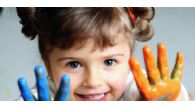Just because
you can buy arts and crafts materials in stores doesn't mean they are free from
health and safety hazards. Some of these materials can be dangerous if you do
not follow all of the safety instructions on the product label.
Important!
If you suffer
headaches, dizzy spells, severe mood swings or feel ill when doing arts and
crafts, leave the project for a while and get fresh air to see if you feel
better. These symptoms could be warning signs that you need to take more steps
to protect your health. If symptoms continue or return, get medical advice.
Health risks
The most common
health hazards from working with arts and crafts materials are cuts from knives
or scissors. But some materials can also burn or irritate your skin and eyes,
cause toxic dust or fumes, or be poisonous if swallowed or inhaled.
These dangers
are even greater for young children, who are smaller, naturally curious and
have a habit of putting things in their mouths. It is important to keep
materials not intended for children out of their sight and reach. For young
artists, buy only materials that are specifically designed to be used by
children, and supervise their use.
Safety tips for children
- Supervise. Supervise
children when using arts and crafts materials.
- Buy
kid-friendly products. Choose products labeled for children's use.
- Keep
materials in their original containers. This way, you can refer to label
instructions and emergency advice later.
- Follow
safety instructions. Always follow the safety instructions on the label.
- Store
carefully. Store all materials out of the sight and reach of
children.
- Don't
serve food or drinks. Don't let children eat or drink when using arts and
crafts materials.
- Ventilate. Do arts
and crafts in a well-ventilated area.
- paint that
is not labelled as "for use by children," powdered clay and
paint, ceramic glaze, copper enamel, and solder for stained glass (may
contain lead or cadmium)
- shellac,
paint strippers, and craft dyes (may contain solvents with toluene or
methyl alcohol, which may cause blindness or other serious health effects
if swallowed)
Safety tips for adults
- Learn
proper techniques. Learn all you can about the materials and
techniques you are using. Take classes or ask an experienced professional.
- Look for
safer alternatives. Do not try or buy new arts or crafts materials
until you have looked into the potential hazards.
- Keep
materials in their original containers. This way, you can refer to label
instructions and emergency advice later.
- Follow
safety instructions. Read and follow the safety
instructions on the label of your arts and crafts materials
every time you use them.
- Do arts
and crafts in a well-ventilated area. Work outside, open a window or
use a fan to draw fumes away from you.
- Install a smoke
detector in your work area. Keep a fire extinguisher close by.
- Know
emergency numbers. Keep the phone number of your nearest Poison Control Centre handy so you can call
right away for advice if there is an emergency.
- Use protective
equipment For example;
- goggles
to protect your eyes from splashes or splinters
- ear plugs
to protect against loud noises
- rubberized
gloves to avoid getting solvents or acids on your skin
- dust
masks or respirators to prevent breathing in dust and fumes
- Don't wear
contact lenses when you work. They can trap dust or splashed liquids, which could
damage your eyes.
- Don't eat
or drink. Keep arts and crafts materials away from food and
drink.
- Wash up. Wash your
hands (and clothing, if needed) after you finish working.
- Store
carefully. Store hazardous materials out of the sight and
reach of children and pets.
- Throw out
carefully. Contact your municipal waste facility for
information on safe disposal of any hazardous waste materials.
Pregnant women should not work with solvents, lead compounds or dust-producing materials. If you are pregnant or planning to get pregnant, talk to your doctor about the risks of toxic arts materials.

 In The Latest Issue:
In The Latest Issue:


 BY:
BY: 

Tweet
Share